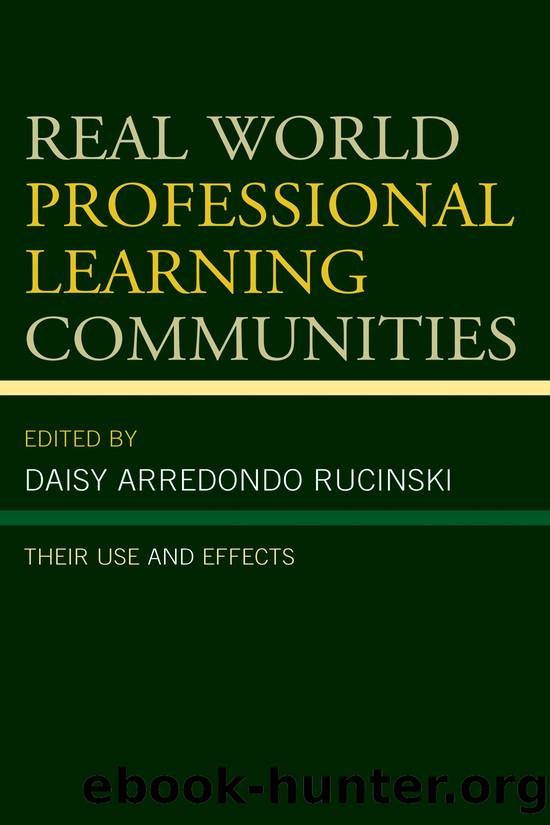Real World Professional Learning Communities by Arredondo Rucinski Daisy;

Author:Arredondo Rucinski, Daisy;
Language: eng
Format: epub
Publisher: Rowman & Littlefield Publishers
Part IV
School, District, and State Contexts in Using PLCs as a School Reform and Accountability Strategy
Chapter 9
Using a Professional Learning Community Framework to Support Response to Intervention in Middle and High Schools
Nicole Spiller
PURPOSE
The study reported in this chapter examined the relationship between PLCs and the implementation of a 2011 US Department of Education requirement, the Response to Intervention (RTI) process at Tier 1, as well as PLC influence on student learning in mathematics at the middle and high school level. In addition, the relationship between an RTI process and student mathematical learning was analyzed.
BACKGROUND INFORMATION
The analysis of data at the school and student level has become more critical as educators examine ways to improve instruction and learning. Data analysis over the last decade has moved from the examination and reporting of summative data that usually show what was not learned, to formative data, which provide information on what is being learned, to diagnostic data that provide specific information prior to instruction that can be used to tailor instruction.
The identification of students with disabilities has also evolved during this period. The Individuals with Disabilities Education Improvement Act of 2004 (P. L. 108â446) (IDEIA) provided a fundamental change in how students were identified as special needs. The new model moved from one that waited on students to fail before additional support was provided (a summative approach) to a structure of early intervention, prior to failure. The RTI teaching model (early formative intervention as the first signs of student learning difficulty) was written into IDEIA to provide schools a methodology for implementing early assistance and intervention (Stoehr, Banks, & Allen, 2011). This process was designed to help students before they begin to fail through a diagnostic and formative approach.
As a Mathematics School Improvement Specialist for Middle and High Schools in central Georgia, I observed school staff working diligently to determine what critical skills and concepts students needed to learn. At this time, identified schools were in the first few years of implementing a universal screener in mathematics at the middle and high school level. A review of literature showed little research on any relationship between PLCs and the RTI process, with almost no studies on middle and high school implementations of RTI, especially when viewed through the lens of mathematics. These observations provided the impetus for my doctoral research focus.
THEORETICAL FRAMEWORK
Professional Learning Communities
As research into methods of improving student achievement advanced, the emergence of improved professional practice by teachers and leaders was seen as a key component. The purpose of PLCs evolved as consultants such as Hord (1997a) and Little (2003) began to analyze a PLCâs effectiveness in relationship to student gains, especially in the critical subjects of math and reading.
Stoehr, Banks, and Allen stated that PLC discussions were initiated as a means of âimproving workplace behavior and enhancing teachersâ skills and knowledgeâ (p. 12). PLCs continue to evolve as researchers examine a PLCâs effectiveness in relationship to student gains. Although researchers have identified several attributes of PLCs, a consensus has yet to be established.
Download
This site does not store any files on its server. We only index and link to content provided by other sites. Please contact the content providers to delete copyright contents if any and email us, we'll remove relevant links or contents immediately.
The Art of Coaching Workbook by Elena Aguilar(50161)
Trainspotting by Irvine Welsh(21070)
Twilight of the Idols With the Antichrist and Ecce Homo by Friedrich Nietzsche(18316)
Fangirl by Rainbow Rowell(8812)
Periodization Training for Sports by Tudor Bompa(7939)
Change Your Questions, Change Your Life by Marilee Adams(7399)
This Is How You Lose Her by Junot Diaz(6470)
Asking the Right Questions: A Guide to Critical Thinking by M. Neil Browne & Stuart M. Keeley(5378)
Grit by Angela Duckworth(5316)
Red Sparrow by Jason Matthews(5218)
Paper Towns by Green John(4820)
Room 212 by Kate Stewart(4760)
Ken Follett - World without end by Ken Follett(4461)
The Sports Rules Book by Human Kinetics(4090)
Housekeeping by Marilynne Robinson(4078)
Double Down (Diary of a Wimpy Kid Book 11) by Jeff Kinney(3950)
Papillon (English) by Henri Charrière(3937)
The Motorcycle Diaries by Ernesto Che Guevara(3798)
Exercise Technique Manual for Resistance Training by National Strength & Conditioning Association(3794)
